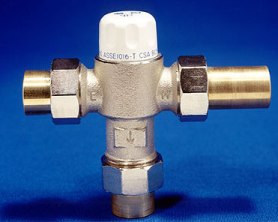Hot water Temperature
Scalding from Hot Water
• Make sure your water heater is set to a safe temperature for home use. Use the industry chart below to provide guidance to avoid scalding.
• Check the water temperature before placing a child in the bathtub.
• Never leave a child alone or with other young children in the bathtub.
Table of Hot Water Scalding Temperatures and Times:
|
Water Temperature Setting |
Exposure Time |
Effects of Exposure to Hot Water at High Temperatures |
|
Water at 100º F or below |
See Safety Note |
Most water heaters are unlikely to scald an adult occupant |
|
Water at 120º F |
5 minutes |
2nd & 3rd degree burns on adult skin |
|
Water at 130º F |
30 seconds |
2nd & 3rd degree burns on adult skin |
|
Water at 140º F |
5 seconds |
2nd & 3rd degree burns on adult skin |
|
Water at 150º F |
1.5 seconds |
2nd & 3rd degree burns on adult skin |
|
Water at 160º F |
.5 second |
2nd & 3rd degree burns on adult skin |
Safety Note: Hot Water Scald Burn Warning for Infants, Children, & Elderly: Great care must be taken when exposing infants or children to warm or hot water as they can be badly burned quickly and at shorter exposure times.
Anti-Scald Valves
Anti-scald valves, also known as tempering valves and mixing valves, mix cold water in with outgoing hot water so that the hot water that leaves a fixture is not hot enough to scald a person.
Facts and Figures
- Scalds account for 20% of all burns.
- More than 2,000 American children are scalded each year, mostly in the bathroom and kitchen.
- Scalding and other types of burns require costly and expensive hospital stays, often involving skin grafts and plastic surgery.
- Scalding may lead to additional injuries, such as falls and heart attacks, especially among the elderly.
- Water that is 160º F can cause scalding in 0.5 seconds.
Unwanted temperature fluctuations are an annoyance and a safety hazard. When a toilet is flushed, for instance, cold water flows into the toilet’s tank and lowers the pressure in the cold-water pipes. If someone is taking a shower, they will suddenly feel the water become hotter as less cold water is available to the shower valve. By the same principle, the shower water will become colder when someone in the house uses the hot-water faucet. This condition is exacerbated by plumbing that’s clogged, narrow, or installed in showers equipped with low-flow or multiple showerheads. A sudden burst of hot water can cause serious burns, particularly in young children, who have thinner skin than adults. Also, a startling thermal shock – hot or cold – may cause a person to fall in the shower as he or she scrambles on the slippery surface to adjust the water temperature. The elderly and physically challenged are at particular risk.
Anti-scald valves mitigate this danger by maintaining water temperature at a safe level, even as pressures fluctuate in water supply lines. They look similar to ordinary shower and tub valves and are equipped with a special diaphragm or piston mechanism that immediately balances the pressure of the hot- and cold-water inputs, limiting one or the other to keep the temperature within a range of several degrees. As a side effect, the use of an anti-scald valve increases the amount of available hot water, as it is drawn more slowly from the water heater. Inspectors and homeowners may want to check with the authority having jurisdiction (AHJ) to see if these safety measures are required in new construction in their area.
Installation of anti-scald valves is typically simple and inexpensive. Most models are installed in the hot-water line and require a cold-water feed. They also require a swing check valve on the cold-water feed line to prevent hot water from entering the cold-water system. They may be installed at the water heater to safeguard the plumbing for the whole building, or only at specific fixtures.
The actual temperature of the water that comes out of the fixture may be somewhat different than the target temperature set on the anti-scald valve. Such irregularities may be due to long, uninsulated plumbing lines or defects in the valve itself. Users may fine-tune the valve with a rotating mechanism that will allow the water to become hotter or colder, depending on which way it’s turned. Homeowners may contact an InterNACHI inspector or a qualified plumber if they have further questions or concerns.
In summary, anti-scald valves are used to reduce water temperature fluctuations that may otherwise inconvenience or harm unsuspecting building occupants.